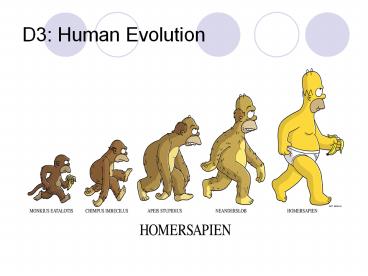D3: Human Evolution - PowerPoint PPT Presentation
Title:
D3: Human Evolution
Description:
D3: Human Evolution D3: Human Evolution D.3.1: outline the method for dating rocks and fossils using radioisotopes, with reference to 14C and 40K D.3.2: Define half ... – PowerPoint PPT presentation
Number of Views:370
Avg rating:3.0/5.0
Title: D3: Human Evolution
1
D3 Human Evolution
2
D3 Human Evolution
- D.3.1 outline the method for dating rocks and
fossils using radioisotopes, with reference to
14C and 40K - D.3.2 Define half-life
- D.3.3 Deduce the approximate age of materials
based on a simple decay curve for a radioisotope
- Pages 484-492 Campbell
3
The Fossil Record
- Fossils are any form of preserved remains from a
living organism - Like bones in rock, insects in amber, frozen
mammoths - The fossil record is the ordered array in which
fossils appear within layers of sedimentary rocks
- Paleontologists collect and determine fossils
- How do we determine their age?
- Contributions and limitations of the fossil
record
4
How are fossils formed?
- If a dead organism gets buried in sedimentary
silt, it will decay slowly and leave a place in
the surrounding silt - They become solid, and fill the exact gap the
organism left behind (like a cast) - The silt around this solidifies, becoming
sedimentary rock - In the rock you find a different looking stone
- Looks like the dead organism ? fossil
- Very few circumstances that fossils are formed
- This is why the fossil record is incomplete
- Most individuals do not leave a fossil after
death - http//www.bbc.co.uk/sn/prehistoric_life/dinosaurs
/making_fossils/
5
Age of fossils
- We can use isotopes to determine the age of
fossils - Isotopes are
- Atoms which have a mass different from most other
atoms - Different number of neutrons
- Unstable will spontaneously change into one or
more atoms of other elements, often emitting
radiation
6
Half life
- This change takes time
- Radioactive decay
- During a fixed interval (depending on the
isotope), half of the amount present will decay - As a result, at the end of the period, the
radioactivity will be half of what is was before - This is called half-life of the isotope
- Half-lives vary from fractions of seconds to
thousand of years - Half-life of14C is 5730 years
7
So to repeat
- Half life the number of years it takes for 50
of the original sample to decay - Unaffected by temperature, pressure and other
environmental factors - http//www.colorado.edu/physics/2000/isotopes/radi
oactive_decay3.html
8
Carbon dating
- Method used to determine the age of organic
material - Involves radioactive 14C
- A normal atom of carbon is referred to as 12C
- 6 protons, 6 electrons, 6 neutrons
- 14C has 6 protons, 6 elections, 8 neutrons
- Unstable spontaneously change to 14N
- Emits radiation
9
Carbon dating
- 14C is present in small amounts on Earth
- All living organisms 14C in the same proportion
as is found in the atmosphere - 14C is emitted by the sun ? photosynthesis
(enters food chain) - After an organism dies, the process of
incorporating new carbon into the body stops - After 5730 years, the amount of 14C present in
the remains is half of what is was at the time of
death - After 11,460 years, it would be ¼
10
Carbon dating
- Accurate and useful for young fossils
(20,000-50,000 years old) - Older material, another isotopes should be chosen
(with a longer half-life) - 40K
- Will decay to form 40Ar (argon)
- Half life 1300 million years
- 238Uranium (volcanoes)
11
How can we use a graph to figure this out?
- At time 0, the fraction of 14C is 1 (the original
amount present the organism just died) - When only ½ the original amount of 14C is present
a time equal to the half-life of the isotope has
passed - 5730 years
- When only 0.125 of the original amount of 14C is
present, 3 half lives have passed - The specimen died 17190 years ago
12
Review
- A paleontologist estimates that when a particular
rock formed, it contained 12 mg of the
radioisotope potassium-40. The rock now contains
3 mg of potassium-40. The half-life of
potassium-40 is 1.3 billion years. About how old
is the rock?
13
Answer
- 2.6 billion years
- Passed through 2 half lives
14
Review
- Your measurements indicated that a fossilized
skull you unearthed has a carbon-14 to carbon-12
ratio of about 1/16 that of the atmosphere. What
is the approximate age of the skull?
15
Answer
- 22,920 years
- 4 half-lives
- 5730 years
16
Absolutely hilarious
- The Simpsons Take on Evolution and Creationism
- http//religiousfreaks.com/2006/07/10/evolution-vs
-creationism-simpsons-style/ - Just click on Ned Flanders































